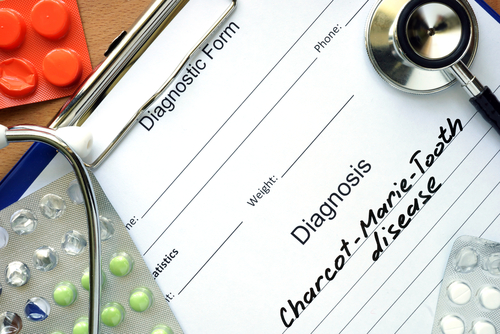Greater Disease Severity and Faster Progression in CMT type 4B1 than CMT4B2, Study Reports

People with Charcot-Marie-Tooth disease (CMT) type 4B1 have earlier onset and faster progression of disease — as well as more common respiratory complications and greater delay in achieving motor milestones — when compared with those with CMT4B2, a study reports.
The study, titled “A multicentre retrospective study of Charcot-Marie-Tooth disease type 4B (CMT4B) due to mutations in Myotubularin-related proteins (MTMRs),” was published in the journal Annals of Neurology.
CMT4B is characterized by its early onset, slowed nerve conduction, and excessive focal formation of myelin — the protective layer of nerve fibers. Its three forms, 1-3, are clinically distinct, and are associated with mutations in different myotubularin-related proteins (MTMRs). The three subtypes are extremely rare, and are mostly reported in countries with high frequency of consanguineous marriages (among those sharing common ancestors).
An international team from 18 centers sought to better characterize CMT4B, assessing correlations between genotype and clinical manifestations, and identifying patients for future natural history studies, as well as trials of potential treatments.
Data were collected between July 2016 and January 2019, including clinical, genetic, and electrophysiological (electrical activity) information. Among the 50 patients studied, 26 had CMT4B1, 19 CMT4B2, and five had CMT4B3.
A total 21 CMT4B1 patients from nine families had a positive family history. In turn, 14 people with CMT4B2 from 12 families had affected family members or consanguineous parents.
The mean age of onset was earlier in CMT4B1 than in CMT4B2 patients (2.8 years vs. 6.7 years). All but one of the individuals with CMT4B1 had lower limb weakness as a first symptom. Four patients from the same family experienced vocal cord symptoms since disease onset. In CMT4B2, the first manifestation was lower limb weakness with walking difficulties in all but two cases. Those individuals first showed hand weakness and tremors, or congenital glaucoma.
Half of the individuals with CMT4B1 and one-fifth of those with CMT4B2 showed delay in achieving motor milestones. Most patients with either subtype developed foot deformities, and nearly half underwent foot surgery. Scoliosis, or spine curvature, was more frequent in CMT4B2 patients (58%) than in those with CMT4B1 (35%).
Age at last visit was considerably higher in those with CMT4B2 than in those with CMT4B1 (31.7 vs. 21.9 years). Four patients with CMT4B2 and 12 with CMT4B1 needed a wheelchair.
Nearly 40% of participants with either of these two CMT4B subtypes had vocal cord palsy and dysphonia (difficulty speaking). Eight people with CMT4B1, and three with CMT4B2, showed respiratory insufficiency, with two of the CMT4B1 patients dying due to this cause.
Six CMT4B2 patients had overt glaucoma, two of whom congenital. Four also had buphthalmia (enlarged eyeball), and five had partial hearing loss. Those with CMT4B1 had more frequent proximal muscle weakness, and overall less disabling sensory loss.
MRC scores of muscle strength were worse in CMT4B1 patients, indicating more severe disease. Comparisons of disease onset, clinical scores, and walking ability within the same family showed less variability in those with CMT4B1. The two subtypes showed similar reductions in nerve conduction velocities.
Genetic analysis revealed 17 different mutations in the MTMR2 gene in CMT4B1 patients, nine of which had been reported. A total 15 mutations were loss-of-function changes — less or no function of the resulting protein — and 11 were found in both gene copies (homozygous).
In turn, the individuals with CMT4B2 showed 24 mutations in the MTMR13/SBF2 gene, only five of which had been reported. In all, 21 were loss-of-function mutations, and 10 were found in both gene copies.
Subsequent analysis revealed that disease severity was significantly associated with age in CMT4B1, worsening per year by 1.9 points in the MRC score, and by 0.17 points in the Charcot-Marie-Tooth Examination Score. No such association was found in CMT4B2. Both of these scores were worse in CMT4B1 than in CMT4B2 patients after adjusting for age.
All but one mutation types showed no correlation with clinical scores.
As for the five patients with CMT4B3 — the rarest subtype — three were sisters from the same Korean family. Analysis revealed demyelinating progressive neuropathy (nerve damage).
The sisters had two missense mutations in the MTMR5/SBF1 gene — changes in the building blocks of DNA, called nucleotides, leading to a different amino acid — predicted to have a mild impact on the resulting protein. All three women were compound heterozygotes, which means that they had two different mutated gene copies.
The other two CMT4B3 patients, from a Syrian family, had axonal (nerve fiber) motor neuropathy with microcephaly — a head smaller than normal — intellectual disability, multiple cranial neuropathies, and imaging findings indicative of abnormal cranial nerves. They carried a homozygous mutation predicted to have a significant impact on the protein function.
“This is the largest CMT4B series ever reported, demonstrating that CMT4B1 is significantly more severe than CMT4B2, and allowing an estimate of prognosis,” the scientists concluded.





